The Wink from Tech Billboards
From Elizabeth Holmes's haunting return to AI-jargon and vice-signaling, Bay Area billboards have become a coded language for a tech world in flux.
I drive a lot. Every week, I make at least one trek from Mountain View to San Francisco and back, watching the Peninsula slide by through my windshield.
Last week, somewhere around Palo Alto, Elizabeth Holmes stared at me from a billboard. Not a lookalike or a reference—her actual face in that iconic black turtleneck, blown up against the sky, eyes following traffic as if she'd never left. My first thought wasn't about what product was being advertised. It was more visceral: Is she back?
It turns out, in a way, yes or no. After some digging, I discovered the billboard is part of a provocative campaign led by laboratory expert and filmmaker Ryan El-Hosseiny. His multimedia project aims to challenge the prevailing narrative around Theranos and its fallen founder. The billboard—deliberately designed to make drivers double-take—perfectly captures Silicon Valley's complex relationship with its own mythology.
I was driving too fast to snap a photo, but later found on Reddit that they've placed another identical billboard in San Jose. Two Elizabeth Holmes faces, haunting two different stretches of Bay Area highway, watching thousands of tech workers commute past her gaze each day.

This billboard left me with the feeling I've had a lot lately while driving around the Bay: what exactly are these billboards trying to say? And to whom?
For the past many months, I've started collecting mental snapshots of the strange, hyper-specific, and often indecipherable billboards that line the highway 101. If you drive through the Peninsula and San Francisco, you know what I'm talking about: Helvetica-heavy slogans. A pitch for a new AI startup that assumes you're already following their founder. Tech jargon that sounds like inside jokes for an iMessage group you were never invited to.
Especially since the AI boom arrived, San Francisco has once again become tech's beacon. As people constantly declare "San Francisco is so back, Bay Area is so back," those billboards plastered with AI jargon have become the most welcoming physical symbols for the AI workforce newly relocated to San Francisco. They symbolize a futuristic city landscape, signifying that this city is filled with messages that "understand you, and that you understand." A tacit recognition between the city and its chosen inhabitants.
The discussions about Bay Area billboards are lively on Reddit and X. Several local media outlets have also covered the topic, from The San Francisco Standard to SFGate, documenting this peculiar communication medium that continues to fascinate both locals and visitors alike.

The Airbnb billboard simply stated "Exit Strategy"—though now gone, it left a lasting impression that this billboard was so entitled to speak only to those who needed a capital exit strategy. I remember driving past it with a VC friend, and we all laughed at it. The inside joke wasn't subtle.
A cloud computing company whose billboard reads: "Compliance that doesn't SOC 2 much." (A pun that makes sense to maybe 0.2% of drivers.)
Another with just a command line prompt: "~/ npm i ai" (If you can read this, congratulations—you're the chosen audience.)
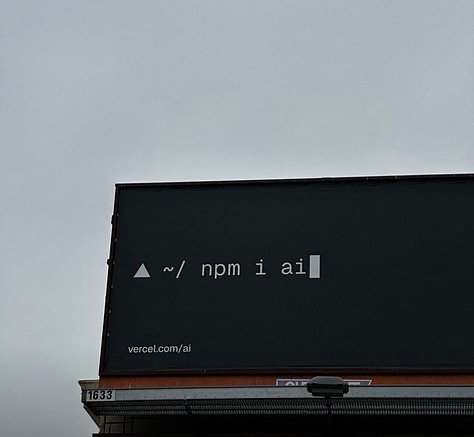
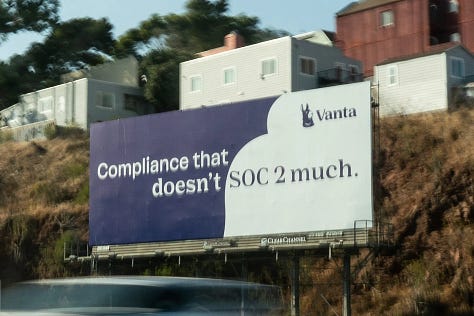
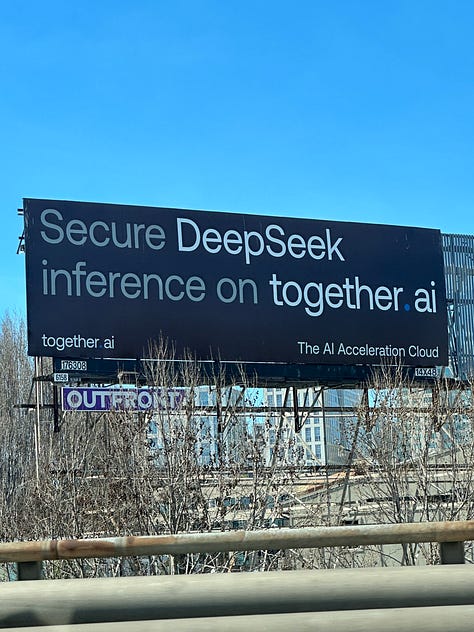

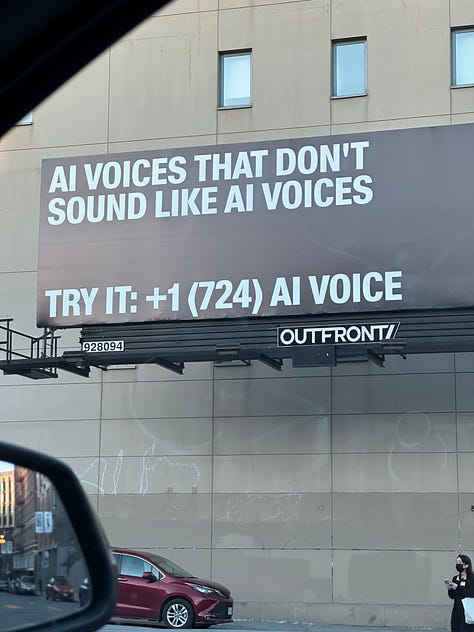
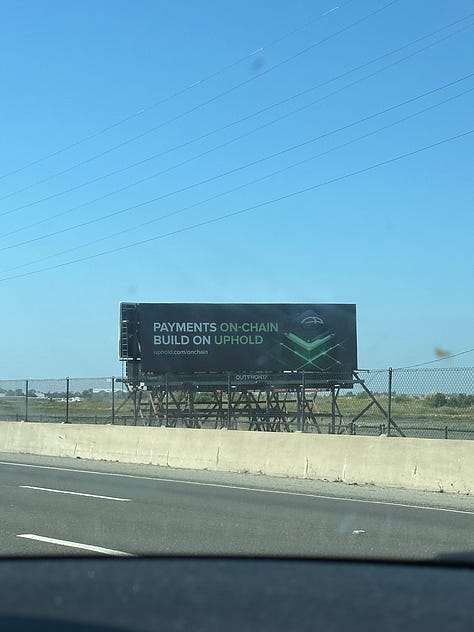
And my personal favorite: "AI VOICES THAT DON'T SOUND LIKE AI VOICES"—a billboard that doesn't even specify what service is being advertised or who the provider is.
None of these are designed to sell anything in the traditional sense. They're not for the average commuter. They're for the insiders, the builders, the ones who already speak the dialect of tech ambition. And yet they use the most democratic, least targeted advertising medium possible: giant signs by the highway.
There's a concept I've been thinking about lately—the culture of observation-while-in-motion. Growing up in China, billboards were straightforward or propagandistic: buy this, go here, do that, build the great socialistic society together.
Unlike the digital ads we curate and scroll past, America’s highway billboards possess a unique power. You cannot skip them; they force you to "see" as you speed by at 70 mph. They demand a glance—a moment of recognition—from thousands of strangers daily. In this fleeting encounter between driver and message, there's something almost ceremonial.
And recently, some Bay Area tech billboards have evolved into something more calculated: vessels for what I call "vice signaling" marketing. Remember that notorious "Stop Hiring Humans" billboard that appeared in San Francisco last year? It was launched by Artisan, an AI sales agent company, specifically to generate controversy. And it worked—photos of the billboard spread across social media like wildfire, generating far more impact than the physical sign itself. The team proudly claimed their "intentional rage baiting" worked, even publishing an article highlighting these dystopian ads' effectiveness. A single tweet of the billboard reached 250,000 people and got 5,000 reposts. But they also claimed, "We didn't expect people to get so mad... nor did we anticipate the level of backlash we received."

This is vice-signaling, but not in service of any coherent ideological position. Parts of Silicon Valley have moved beyond simple anti-woke posturing into something more nihilistic: an absence of moral compass. "All marketing is good marketing" and "Any Attention is Good Attention" have become unofficial mottos in an ecosystem where traditional growth hacking and SEO tactics no longer deliver the results they once promised.
This moral vacuum isn't just aesthetics—it's strategy. When engagement algorithms reward controversy above all else, ethical ambiguity becomes a growth hack.1 The physical billboard transforms into a vessel not just for the message itself, but for the spectacle of the message. The billboard becomes a marketing phenomenon, designed to be photographed, shared, debated, and condemned on social media, creating ripples far beyond the highway and conference center.
Billboards used to be for accident attorneys and fast food. They sold services to everyone, indiscriminately. They belonged to the old economy—the one that advertised cheap hamburgers, mattresses, real estate agents.
Now, they sell mood, vibe, aesthetic, and ideology. And in the Bay Area, they also sell... a strange, encrypted kind of belonging.
We used to flaunt being in tech. Now, post-techlash, post-pandemic, post-crypto-bear, being in tech comes with more cultural baggage. The billboards reflect this evolution. In 2014, they promised to "change the world." In 2018, they reassured us they were "making a difference." Now in 2025, they're speaking in code—communicating to their tribes while barely acknowledging anyone else exists.
What fascinates me is how these billboards represent an anachronistic fusion—old media carrying new vernacular. In an era when almost everything tech-related has gone digital, personalized, and algorithm-driven, these physical, analog messengers stand defiantly along our highways.
So the billboards in the Bay Area have adapted. They're no longer broadcasting. They're winking. If you get it, you get it. If you don't, you're not the target. In a way, it's kind of fascinating. There's something tender about watching a city try to maintain its identity while publicly second-guessing it.
So I keep looking. Driving, decoding, wondering what the next Helvetica ghost-message will say. They don't care if you're winking back. But they always know when you are.
So, what baffling billboards have you spotted?
I am working on a piece about Silicon Valley's "vice-signaling" marketing, examining figures like Bryan Johnson, He Jiankui, Elon Musk, and phenomena like Solana's memecoins.



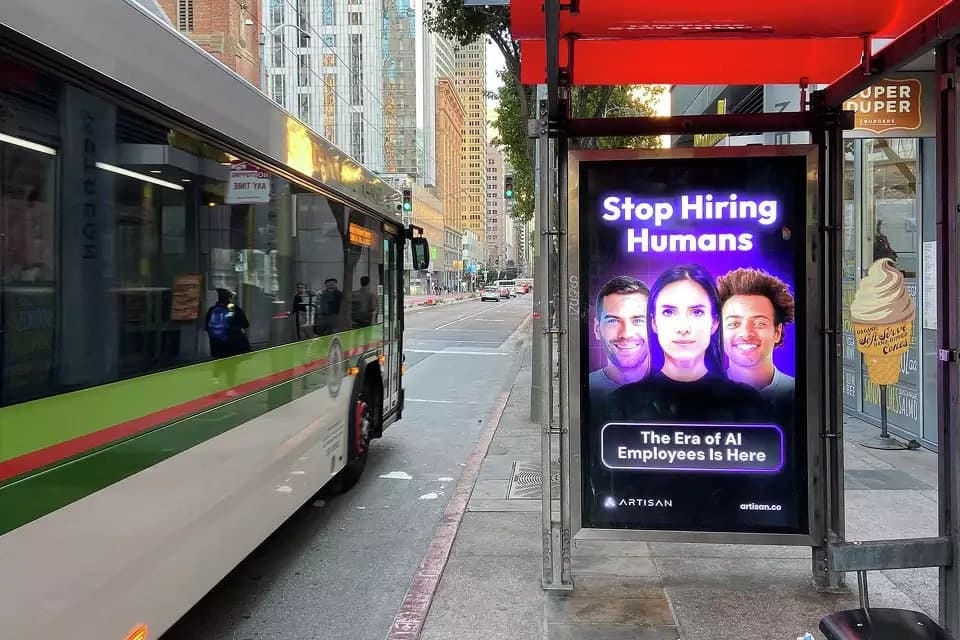
my partner and i always discuss the billboards whenever we drive through the city, noticing the new additions and updates and wondering what the companies are even trying to say with each one. your essay is really insightful with pulling together how the billboards are winking, making inside jokes, and vice-signaling in this weird combination of ragebait, humble-brag, sheepishness, self-consciousness/awareness, etc.
everything about this piece is absolutely brilliant